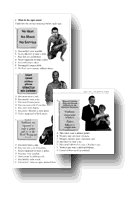|
|
|
|
|
|
|
Back to |
![]()
Not
Just A Workbook:
Handshake workbook
There is a Workbook unit for each Student Book unit.The workbook units have three parts:
> Thinking about learning
This section comes at the beginning of each workbook unit. You can do it before the unit or at any time during the unit.
These sections promote learner autonomy. They are:
Practice unit: Vocabulary, grammar and communicationUnit one: How do you learn?
Unit two: Positive attitudes
Unit three: Assessing your own abilities
Unit four: Types of Intelligence
Unit five: Working alone or with others
Unit six: Exercise types
Unit seven: Classroom Activities
Unit eight: Your future
|
Here is an example from unit seven. You may want to try this on your own. It will tell you a lot about your preferences as a teacher. There are no illustrations.
|
|
> Sections
In this Workbook the section headings have the same titles as the Student Book sections. Use each Workbook section after the Student Book section.
Remember that there is also a Language Focus section in the Student Book.
As in the student book, the sections are:
Practice unit: RequestsUnit one: Opening and closing
Unit two: Non-verbal communication
Unit three: Exchanging information
Unit four: Social interaction
Unit five: Conversation strategies
Unit six: Presentation
Unit seven: Expressing feelings
Unit eight: Case study
Here are some examples:
|
Mind Map This is from unit one, Opening and Closing. The Mind Map gives free vocabulary practice as well as making students think about body language and culture. |
|
|
How often? This is from unit two, Non-verbal communication. Work on proximity also practises frequency adverbs and extends and reinforces vocabulary.
|
|
Origins There are two sections from unit three, Exchanging Information on this page. The first one gets students to work imaginatively on a fun exercise (which will recycle the present simple), while the exercises under origins recycle the past simple. You will notice that the four exercises are progressively less-controlled.
|
|
Receiving information: Making calls & receiving calls This is also from unit three, Exchanging Information. The exercise requires global comprehension and the second continues work on dictionary |
|
What do the signs mean? This is from unit four, Social interaction. As well as the surface teaching point (Appropriate dress), you will see that the activity thoroughly reviews modal verbs for obligation and prohibition. |
|
What are they saying? This is from unit four, Social Interaction. It practises suggestions and invitations.
|
Adverbs of degree
this comes from unit five, Social interaction. This is a straightforward grammar exercise which makes students THINK about grammar.

Talking about graphs
A vocabulary exercise which combines with information on presentation.

> After you've finished
After you've finished work on the Student Book and Workbook unit, you can do this section. There is a Skills check and a Grammar check.
|
|
|
This example is from unit one. The illustration is one we’re particularly fond of. The artist, Chris Price, was at the University of Hull with Peter. They were in the same hall and the same seminar group. Peter & Chris hadn’t been in contact for twenty-five years, when OUP commissioned Chris to do the art for this unit. Chris has done many illustrations for OUP and his work features in ‘The Observer’ and ‘The Daily Mail’ newspapers. |
|
|











